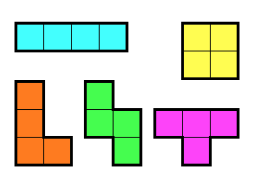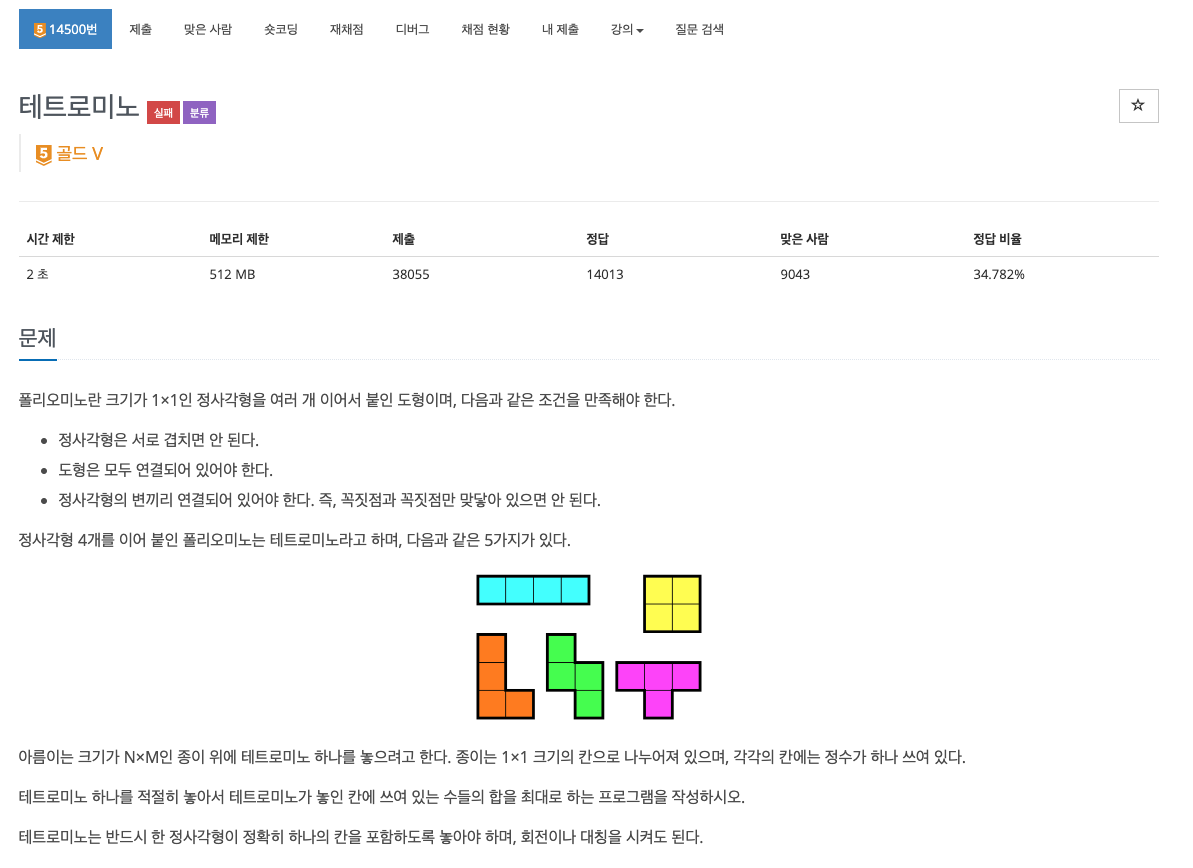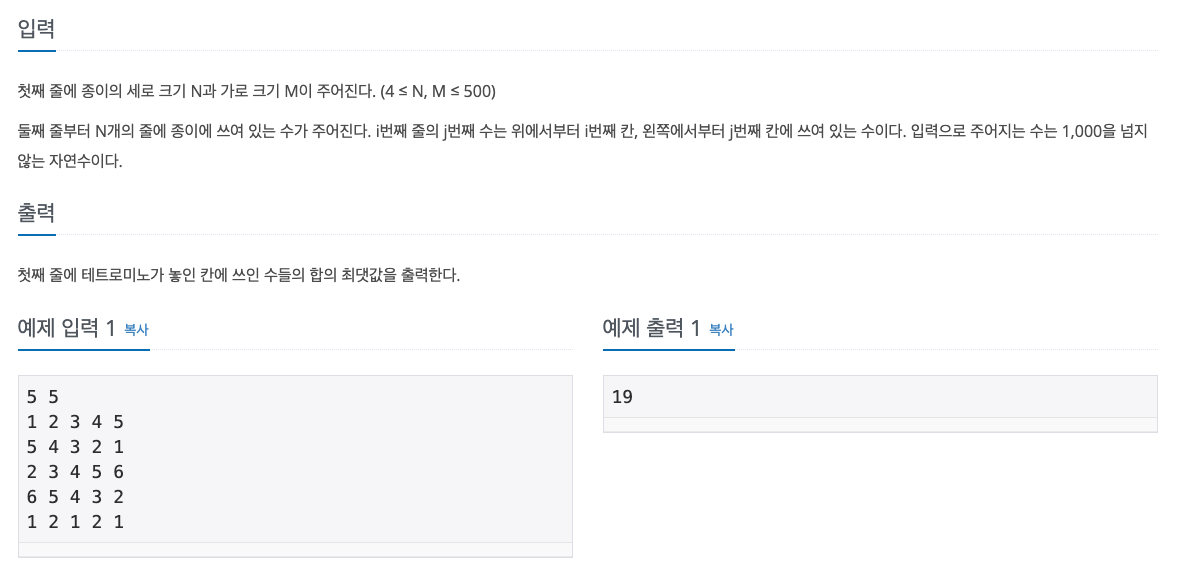#include <cstdio>
#include <vector>
#include <queue>
#include <iostream>
#include <cmath>
#include <algorithm>
#include <set>
#include <deque>
#define ll long long
#define ull unsigned long long
using namespace std;
int dx[4] = {0, 1, 0, -1};
int dy[4] = {1, 0, -1, 0};
int N,M,ans;
int board[505][505];
int main() {
ios::sync_with_stdio(0);
cin.tie(0);
cout.tie(0);
cin >> N >> M;
for(int i=0;i<N;i++)
for(int j=0;j<M;j++)
cin >> board[i][j];
int ch[N*M];
fill(ch, ch+N*M, 1);
for(int i=0;i<4;i++)
ch[i] = 0;
do{
bool tmp[N][M];
bool vis[N][M];
int sum=0;
pair<int,int> start = {-1,-1};
for(int i=0;i<N;i++)
{
fill(tmp[i], tmp[i]+M, false);
fill(vis[i], vis[i]+M, false);
}
for(int i=0;i<N*M;i++)
if(ch[i] == 0){
int ny = i/M;
int nx = i%M;
tmp[ny][nx] = true;
sum += board[ny][nx];
if(start.first == -1)
start = {ny,nx};
}
queue<pair<int,int>> q;
q.push(start);
vis[start.first][start.second] = true;
int cnt=1;
while(!q.empty())
{
auto cur = q.front(); q.pop();
for(int dir=0;dir<4;dir++)
{
int ny = cur.first + dy[dir];
int nx = cur.second + dx[dir];
if(nx<0 or ny<0 or nx>=M or ny>=N) continue;
if(vis[ny][nx] or tmp[ny][nx] == false) continue;
cnt++;
vis[ny][nx] = true;
q.push({ny,nx});
}
}
if(cnt < 4) continue;
ans = max(ans, sum);
}while(next_permutation(ch, ch+(N*M)));
cout << ans;
return 0;
}
- 로직
N*M개의 점들 중 인접한 4개의 점 을 골라서 합을 구하는 방식으로 최대값을 구함
(next_permutation을 이용한 조합으로 경우의 수를 구하기)
- 결과
: 시간초과
next_permutation() --> O(N*M)next_permutation() 내부 에 있는 vis, tmp 초기화 --> O(N*M)- 총
O((N*M)^2) = O(250000*250000) = 약 O(10^10)
- 깨달은 것
next_permutation으로 조합을 구할 때 ch를 1로 초기화 한 후 뽑을 개수만큼 0으로 초기화 해야함
(반대로 0으로 초기화하고 1로 넣으면 올바르게 실행되지 X)
#include <cstdio>
#include <vector>
#include <queue>
#include <iostream>
#include <cmath>
#include <algorithm>
#include <set>
#include <deque>
#include <numeric>
#define ll long long
#define ull unsigned long long
using namespace std;
int dx[4] = {0, 1, 0, -1};
int dy[4] = {1, 0, -1, 0};
int N,M,ans;
int board[505][505];
bool vis[505][505];
vector<int> arr(4);
void DFS(int y, int x, int depth)
{
if(depth == 4){
int sum=0;
for(auto a : arr)
sum += a;
ans = max(ans, sum);
return;
}
for(int dir=0;dir<4;dir++)
{
int ny = y + dy[dir];
int nx = x + dx[dir];
if(nx<0 or ny<0 or nx>=M or ny>=N) continue;
if(vis[ny][nx]) continue;
vis[ny][nx] = true;
arr[depth] = board[ny][nx];
DFS(ny, nx, depth+1);
vis[ny][nx] = false;
}
}
bool check(int y, int x){
if(y<0 or x<0 or y>=N or x>=M) return false;
return true;
}
void good(int y, int x){
int result=0;
if(check(y,x) and check(y+1,x) and check(y+1,x-1) and check(y+1,x+1)){
int sum= board[y][x] + board[y+1][x] + board[y+1][x-1] + board[y+1][x+1];
result = max(sum, result);
}
if(check(y,x) and check(y,x-1) and check(y-1,x-1) and check(y+1,x-1)){
int sum = board[y][x] + board[y][x-1] + board[y-1][x-1] + board[y+1][x-1];
result = max(sum, result);
}
if(check(y,x) and check(y-1,x) and check(y-1,x-1) and check(y-1,x+1)){
int sum = board[y][x] + board[y-1][x] + board[y-1][x-1] + board[y-1][x+1];
result = max(sum, result);
}
if(check(y,x) and check(y,x+1) and check(y-1,x+1) and check(y+1,x+1)){
int sum = board[y][x] + board[y][x+1] + board[y-1][x+1] + board[y+1][x+1];
result = max(sum, result);
}
ans = max(result, ans);
}
int main() {
ios::sync_with_stdio(0);
cin.tie(0);
cout.tie(0);
cin >> N >> M;
for(int i=0;i<N;i++)
for(int j=0;j<M;j++)
cin >> board[i][j];
for(int i=0;i<N;i++)
for(int j=0;j<M;j++)
{
vis[i][j] = true;
DFS(i,j,0);
vis[i][j] = false;
good(i,j);
}
cout << ans;
return 0;
}
- 핵심 아이디어
'ㅗ' 모양의 블럭을 제외한 나머지 블럭은 모두 4-depth의 DFS로 탐색 할 수 있다
DFS + 모든 점에 대해 'ㅗ'블럭의 경우의수 4가지 에 대한 합을 구해 최대값을 산출
- 시간복잡도
DFS() --> O(19) : 한 점에 대해 4-depth가 나오는 경우는 19가지good() --> O(1) - 총 =
O(N*M) = O(250000) = O(10^5)
: 모든 점에 대해서 DFS()와 good() 수행



